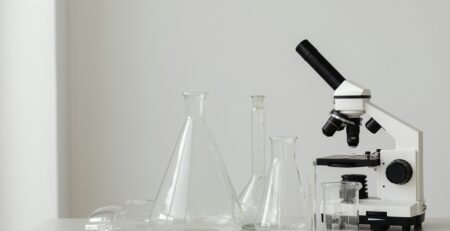1
Sep
Round Bottom vs Flat Bottom Flasks: Choosing the Right Boiling Flask
Separatory funnels are indispensable for liquid–liquid extractions, a technique widely used in organic chemistry, pharmaceuticals, and educational labs. Choosing the right funnel — whether pear-shaped or cylindrical, with glass or PTFE stopcocks — ensures accuracy, safety, and long-term performance. For Australian laboratories, understanding the options helps balance cost, compliance, and usability.
Why Separatory Funnels Are Essential
Separatory funnels allow chemists to isolate and purify immiscible liquids, such as separating organic solvents from aqueous solutions. Their tapered shape and stopcock mechanism provide controlled phase separation, minimising sample loss and contamination.
LabChoice Australia supplies BORO 3.3 borosilicate glass funnels in a variety of capacities, designed to meet ISO 4800 standards for laboratory separations.
Separatory Funnel Comparison
| Feature | Pear-Shaped Funnel | Cylindrical Funnel |
|---|---|---|
| Design | Narrow bottom, promotes efficient separation | Straight body, greater volume capacity |
| Ease of Use | Easier to drain lower phase completely | Easier to clean and fill |
| Common Use | Educational and small-scale extractions | Industrial or preparative chemistry |
| Feature | Glass Stopcock | PTFE Stopcock |
|---|---|---|
| Durability | Strong, traditional, resistant to solvents | Chemically inert, self-lubricating |
| Maintenance | Requires grease for smooth operation | No grease required, lower maintenance |
| Best Use | Classic lab setups, teaching | High-precision work, analytical chemistry |
Choosing the Right Size and Material
- Small Capacity (50–250 mL): Ideal for student labs and micro-scale organic experiments.
- Medium Capacity (500–1000 mL): Common in research labs for preparative work.
- Large Capacity (2000 mL+): Suitable for industrial or large-scale separations.
For example, a Melbourne university teaching lab equips students with 250 mL pear-shaped funnels with glass stopcocks, while a Sydney pharmaceutical lab prefers 1000 mL cylindrical funnels with PTFE stopcocks for precise, high-throughput extractions.
LabChoice BORO 3.3 Advantage
All LabChoice separatory funnels are manufactured from BORO 3.3 borosilicate glass for maximum resistance to thermal shock and chemical attack. With reinforced joints and precision-ground stoppers, they are built for repeat use in demanding environments, from classrooms to regulated industry labs.
FAQs
Are PTFE stopcocks better than glass?
PTFE is lower maintenance and resists chemicals, while glass offers traditional durability and lower cost.
Can separatory funnels be autoclaved?
Yes, BORO 3.3 glass funnels withstand repeated autoclaving. Always remove PTFE parts before sterilisation.
Which shape is best for beginners?
Pear-shaped funnels are easier to drain fully, making them ideal for students and routine teaching.
Do LabChoice funnels comply with ISO standards?
Yes, all LabChoice separatory funnels are manufactured to ISO 4800 compliance.
📚 References
Standards & Specifications
- ISO 4800:2016 – Laboratory glassware — Separating funnels and cylindrical funnels. International Organization for Standardization.
https://www.iso.org/standard/64742.html - ASTM E1095-99(2015) – Standard Specification for Glass Separatory Funnels. ASTM International.
https://www.astm.org/e1095-99r15.html - ASTM E438-20 – Standard Specification for Glasses in Laboratory Apparatus (BORO 3.3 performance standards). ASTM International.
https://www.astm.org/e0438-20.html
Academic & Safety Guides
CSIRO – Laboratory Glassware Handling Guide – Safety and Maintenance of Separatory Funnels in Research Labs. CSIRO, Australia.
https://www.csiro.au
American Chemical Society (ACS) – Safe Use of Separatory Funnels in Organic Chemistry. ACS Safety Resources.
https://www.acs.org/safety
University of Melbourne – School of Chemistry – Undergraduate Organic Chemistry Laboratory Manual: Separatory Funnel Techniques. Melbourne, Australia.

